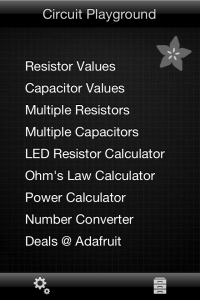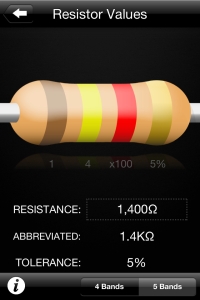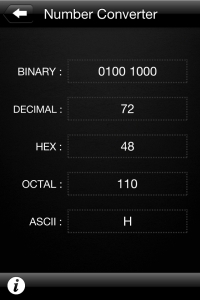Its not everyday that we review software around here, but the folks at Adafruit recently put together an iOS app that I figured might be of interest. Their iPad/iPhone compatible application is called Circuit Playground, and it includes all sorts of handy electronics reference tools. For the context of this review, it should be noted that I paid for the application myself, and that I have had no communication with the Adafruit team regarding my assessment of the app.
As you can see from the main screen, the app currently features eight different tools, not counting the Deals @ Adafruit entry, since I consider that to be more of a marketing strategy than a real tool. The rest of the items are pretty standard reference fare, in an easy to use and understand package.
The Resistor Value tool is pretty straightforward, allowing you to specify resistance in two ways. You can select the color bands of your resistor and view the resulting value, or enter the resistance to see what color resistor you should be looking for. It supports both 4 and 5 band resistors as you would expect, and features a simple Instruction Page (as do all the tools), accessible via the small information icon on the bottom left corner of the screen. One thing I would love to see implemented is the ability to photograph components and display their resistance. I think it would be a very helpful addition for makers whose eyesight isnt what it used to be.
The Multiple Resistor and Multiple Capacitor tools are similar in function, showing you the resultant resistance/capacitance of various series and parallel component setups. They both support up to 9 items apiece, and let you select the capacitance and resistance values for each component one at a time. This is both good and bad, as it gets pretty tedious entering each value manually after a bit. One other item that I thought could use improvement here was the functionality of switching between series and parallel configurations or adding/removing components. Any time a change is made to the configuration, all of the values are reset – this means that if you add another resistor to your 8-resistor diagram, you must re-enter each and every value.
The LED Resistor Calculator does exactly as its name suggests, much like many online calculators that have come before it. This handy feature lets you pick your LED color from a pre-determined list, populating the forward voltage and current fields automatically, based on some common/standard values. Once you specify a supply voltage and quantity of LEDs, the application returns the exact resistance required to meet your specs, along with the value of the nearest standard resistor. While the tool is certainly helpful when calculating resistors for LEDs in series, it lacks any sort of ability to do the same for parallel configurations. If the folks at Adafruit included that functionality along with the ability to customize the default LED list, I would be thrilled. I do have to point out however, that this tool does retain the LED count and supply voltage when changing LED colors, which is something I was glad to see after playing around with the Multiple Resistor tool.
The Ohms Law calculator is a simple tool that is great for allowing me to carry out quick sanity checks of the math I have done in my head. Simply enter two values in the triangle, and Circuit Playground spits out the third. The Power Calculator is a similarly straightforward tool, which takes in two of four values (Power, Voltage, Current, Resistance), calculating the rest for you. Neither tool is overly complicated, but then again they dont need to be.
The final calculator that the app provides makes number conversions dead simple. Given one number, the converter will give you its representation in binary, decimal, hexadecimal, octal, and ASCII notation. While it might not be something that Ill use every day, it certainly is a very helpful reference tool. I personally think that this tool would benefit from the ability to convert strings of characters/numbers rather than one at a time, but perhaps that is something they are looking to add in a forthcoming release.
One of Circuit Playgrounds features that is not as prominent as the others on the main menu is the built-in datasheet viewer. It uses a lightweight interface to help search through and view PDF files located in the iPhones document store. I don’t have anything of the sort stored on my phone so I cant truly test this portion of the app – let us know in the comments how it works for you.
A few data persistence nitpicks aside, I think that Circuit Playground is a solid app with a lot of potential. At $2.99 it sits at the higher end of the App Store pricing structure, so whether or not these tools are worth it is ultimately up to you. Adafruit does say that anyone who purchases the app gets $3 off their next order in their online store, which essentially makes the app free if you are a regular customer.
While its not designed for your seasoned Electrical Engineer, it is definitely a great resource for the part-time tinkerers out there. At the moment, it is an iOS-only offering, but Adafruit says that they will be releasing an Android version at some point in the future. In the meantime, they suggest giving ElectroDroid a try, as it is currently the best app on that platform.
Filed under: iphone hacks, software hacks, tool hacks







Tags for this Thread
+ Reply to Thread
Results 1 to 1 of 1
-
02-07-2012, 05:33 PM #1
Circuit Playground An electronics reference app from Adafruit
Thread Information
Users Browsing this Thread
There are currently 1 users browsing this thread. (0 members and 1 guests)
Similar Threads
-
Electronics Help - finding circuit values?
By S O C C E R:B O Y in forum Electronics, Computer Discussion & Help DeskReplies: 0Last Post: 09-20-2011, 05:00 AM -
Does anyone know of any free electronics circuit simulators?
By Torey in forum Electronic and Computer NewsReplies: 0Last Post: 01-20-2011, 05:36 AM -
electronics circuit change?
By Mohsin in forum Electronics, Computer Discussion & Help DeskReplies: 0Last Post: 07-06-2010, 01:35 AM -
i need help in electronics circuit.?
By Ganduulga in forum Electronics, Computer Discussion & Help DeskReplies: 0Last Post: 06-04-2010, 10:49 AM -
Where can I get used circuit boards and other electronics giddies.
By Justin H in forum Electronics, Computer Discussion & Help DeskReplies: 2Last Post: 08-15-2008, 09:42 PM













 Reply
Reply
Bookmarks